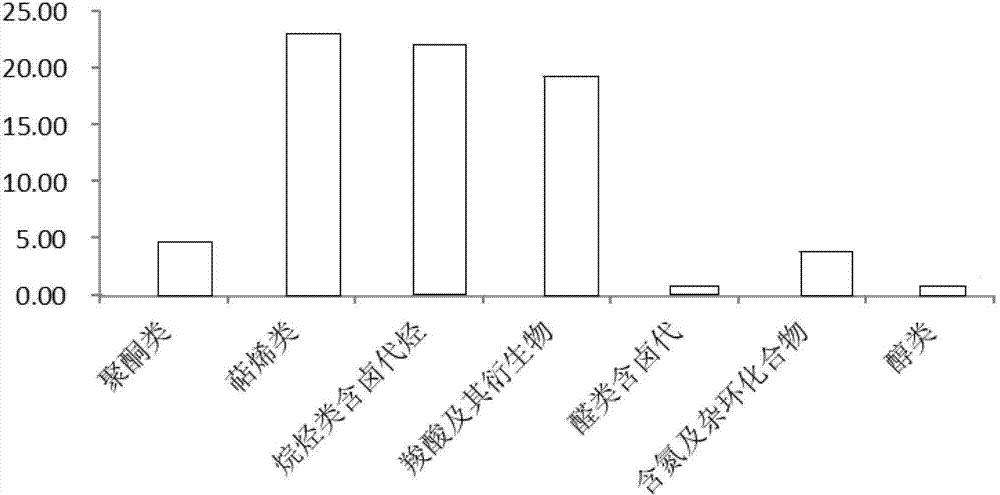Trichoderma strain for antagonizing soil-borne disease
A technology of soil-borne diseases and Trichoderma, applied in the direction of fungicides, fungi, and methods based on microorganisms, can solve problems affecting cucumber production and yield, and achieve strong specialization, fast growth, and large spore production Effect
- Summary
- Abstract
- Description
- Claims
- Application Information
AI Technical Summary
Problems solved by technology
Method used
Image
Examples
Embodiment 1
[0019] Example 1 , Antibacterial test in vitro
[0020] Flat plate confrontation culture method: Use a sterilized Φ6mm puncher to punch out Trichoderma and pathogenic bacteria (Fusarium moniliforme, Fusarium graminearum, Rhizoctonia solani) for about 4 days. Place on one side of a petri dish with a diameter of 90 mm, and inoculate Trichoderma bacteria on the other side, with a distance of 4 cm between the two bacteria plates, and use a single pathogenic fungus as a control, 3 replicates, and culture at a constant temperature of 28 °C. After 5 days of culture, the diameters of pathogenic fungal colonies in the treatment group and the control group were measured by the cross method, and the inhibition rates after 5 days of culture were calculated.
[0021] Colony growth diameter (mm) = average value of colony diameter - 6.0mm;
[0022] Mycelial growth inhibition rate (%) = (control colony growth diameter - treatment colony growth diameter) / control colony growth diameter × 1...
Embodiment 2
[0026] Example 2 , Determination of the survival rate of pathogenic spores
[0027] Through the full contact of pathogenic bacteria (Fusarium oxysporum, Fusarium graminearum, Rhizoctonia solani) with the spore suspension of biocontrol bacteria, four pieces of 5mm-diameter bacteria cakes were taken from the edge of the activated pathogenic bacteria for 5 days, and the Dip into Trichoderma spore suspension (10 6 cells / mL) for 30s, and then cultured overnight in a petri dish covered with 3 layers of wet filter paper. The sterile water was used to replace the Trichoderma spore suspension as a control, and the next day, the pathogenic bacteria cake was transferred to a culture medium containing 1 mg / L benzene In the prodazim selective medium, cultivate in a constant temperature incubator at 28°C, and repeat 3 times. The test results were recorded on the 5th day, and finally expressed in the growth diameter and survival rate of pathogenic bacteria, and the average value was taken...
Embodiment 3
[0031] Example 3 , Greenhouse live control test
[0032] Activate pathogenic bacteria and Trichoderma in PDA medium and culture them at 28°C for 7 days, rinse the spores of pathogenic bacteria on the medium with sterile water, filter the bacterial solution with sterilized filter paper to remove hyphae, and add appropriate amount of distilled water to the filtrate for pathogenic bacteria Dilute to a spore concentration of 1×10 6 individual / mL suspension, Trichoderma dilute the filtrate with appropriate distilled water to a spore concentration of 1×10 7 Individual / mL suspension, set aside.
[0033] (1) Cucumber Fusarium wilt control experiment
[0034] The surface-sterilized cucumber seeds were germinated in a petri dish with double-layer wet filter paper, 6 seeds per dish, and repeated 3 times. Moisturize and cultivate with sterile water for several days. After the seeds germinate and remove the seed coat, plant cucumber seedlings in pots in the greenhouse. When the cucumber...
PUM
| Property | Measurement | Unit |
|---|---|---|
| width | aaaaa | aaaaa |
| length | aaaaa | aaaaa |
Abstract
Description
Claims
Application Information
 Login to View More
Login to View More - R&D
- Intellectual Property
- Life Sciences
- Materials
- Tech Scout
- Unparalleled Data Quality
- Higher Quality Content
- 60% Fewer Hallucinations
Browse by: Latest US Patents, China's latest patents, Technical Efficacy Thesaurus, Application Domain, Technology Topic, Popular Technical Reports.
© 2025 PatSnap. All rights reserved.Legal|Privacy policy|Modern Slavery Act Transparency Statement|Sitemap|About US| Contact US: help@patsnap.com



